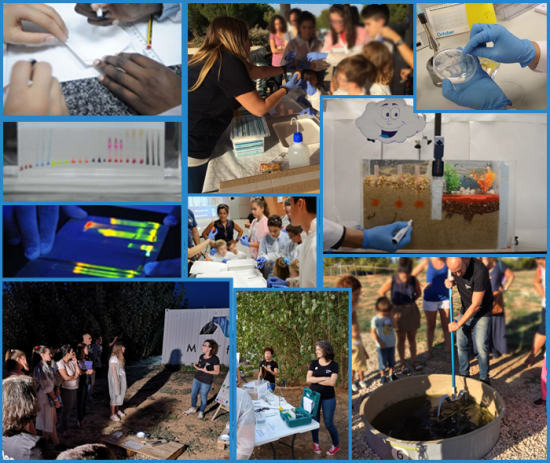Full capacity
Time
Viernes 24. 18:00, 18:30, 19:00, 19:30, 20:00, 20:30
Patrocinadores
- o Proyecto INREMEM 2.0 - Ref. RTI2018-096042-B-C21 (MCI/AEI/FEDER, UE)
- o Proyecto Nanoclean - Ref. PID2019-111519RA-I00 / AEI / 10.13039/501100011033
- o Proyecto LIFE Transfomem - Ref. LIFE13 ENV/ES/000751
- o Proyecto BIOARBIO. Ref. IND2019/AMB-17191
- o Proyecto FatePharM. Ref. CTM2017-89995-R (AEI/FEDER, UE)
- o Proyecto ECORISK2050. G.A. nº: 813124
- o Proyecto CICLIC ECOREST. Ref. RTI2018-097158-A-C32 (MCIU/AEI/FEDER, UE)
- o Proyecto μNanoCare. Retos Colaboración; Ref. RTC2019-007261-5
Reservation is required via email: eventos.agua@imdea.org
In addition to these workshops, attendees will be able to participate in the other activities organized by IMDEA Water from 6pm to 9pm. (No reservation is required for these other activities).
WORKSHOP 1: What do sea water and an egg have in common? Come and we will tell you the secret. 18:00-18:20
What is the relationship between an egg and water purification? Would you drink sea water? What is a membrane? We will find all the answers to these questions and their relationship with water by means of an activity in which we will learn a multitude of related concepts conducting a scientific experiment that you would be able to repeat at home.
WORKSHOP 2: Microscopic life under UV light. 18:30-18:50
Thanks to UV light, a relationship will be established between fluorescent substances and the presence of microorganisms and organic matter on our hands. With this introduction we will begin to know microscopic life: what types of microorganisms exist and where we can find them in nature. We will continue explaining how we can detect the presence of microorganisms in water in the laboratory: how we “fish” them, what we “feed” them, how we see them….
WORKSHOP 3: Mesocosms: a miniature aquatic world. 19:00-19:20
There will be a guided visit to the experimental station of the Ecotoxicology group of the IMDEA Water Institute. Through this visit we will show some mesocosms and explain what they are used for and the outcomes of our last experiments. Then we will show the different sampling materials that are used to assess population dynamics of algae and aquatic invertebrates. Finally, there will be a demonstration where we will collect macroinvertebrate traps, and we will count and identify them in vivo. Through this activity, participants will learn to identify invertebrates that show good water quality and to value the aquatic biodiversity.
WORKSHOP 4: Detection of inorganic pollutants in the environment. 19:30-19:50
The activity will consist of carrying out a simulation of the movement of a pollutant through the soil using a model. With the help of this model, we will be able to see in a very visual way how this pollutant moves through the soil, represented by a dye, through the flow lines that are formed thanks to the contribution of water that we will add to accelerate the process. In this way we will see if this pollutant can affect ecosystems that are far from the initial point of contamination.
We will explain how a sample collection would be carried out to analyze different parameters and we will see some biological indicators of quality, macro and micro invertebrates, collected in different rivers of the Community of Madrid in our multiple field trips to collect samples.
WORKSHOP 5: Nature-based solutions: A different way to treat water. 20:00-20:20
The European Green Deal promotes the use and development of environmentally friendly water treatment technologies. With this aim, the Soil and Water Quality in the Environment group is working to optimize one of these systems: vegetation filters. Vegetation filters are "nature-based solutions" for water treatment and reuse that provide environmental, social and economic benefits. In them, wastewater is treated by the combined action of soil, microorganisms and vegetation.
The workshop will take place in the pilot vegetation filter installed at IMDEA Agua, where its operation, natural attenuation processes and water quality monitoring and tracking systems will be explained. Visitors will be able to sample groundwater and quantify some parameters to verify its treatment efficiency, using in situ measuring devices (pH, conductivity, nitrogen and ammonium). Visitors will participate in the scientific process beyond the boundaries of the laboratory, the results will be shared and discussed.
WORKSHOP 6: Separation of components containing on ink highlight pen by think layer chromatography technique separation. 20:30-20:50
River waters can contain pesticides, pharmaceuticals, additives and other pollutant substances which could affect to water quality and their organisms. The work carried out in IMDEA Water laboratory is to separate and identify these contaminants in order to study their concentration and effects on the environment.
With this practice we want to simulate the detection of pollutants in water by using a marking pen and separating the colorants, binders, solvents in mixture by think layer chromatography. This technique allows the separation of chemical compounds with different behaviour between two phases: mobile (liquid) and stationary (solid). The mobile phase is a mixture of apolar solvents, and the stationary phase is silica with polar properties. As a result, the most polar components will be more retained on polar stationary phase and the most apolar compound will have a high solubility in apolar mobile phase. Therefore, the compound velocity separation will depend on their polar properties.
